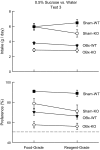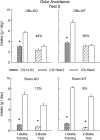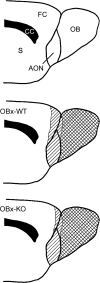Role of olfaction in the conditioned sucrose preference of sweet-ageusic T1R3 knockout mice
- PMID: 19736224
- PMCID: PMC2745352
- DOI: 10.1093/chemse/bjp055
Role of olfaction in the conditioned sucrose preference of sweet-ageusic T1R3 knockout mice
Abstract
Prior work has shown that sweet taste-deficient T1R3 knockout (KO) mice developed significant sucrose preferences when given long-term sugar versus water tests. The current study investigated the role of olfaction in this experience-conditioned sucrose preference. T1R3 KO and C57BL/6 wild-type (WT) mice were given 24-h sugar versus water tests with ascending concentrations of sucrose (0.5-32%), after which the mice received olfactory bulbectomy (OBx) or sham surgery. When retested with sucrose, the Sham-KO mice preferred all sugar solutions to water, although their intake and preference were less than those of the Sham-WT mice. The OBx-KO mice, in contrast, showed no or weak preferences for dilute sucrose solutions (0.5-8%) although they strongly preferred concentrated sugar solutions (16-32%). OBx-WT mice displayed only a partial reduction in their sucrose preference. Although the OBx mice of both genotypes underconsumed dilute sucrose solutions relative to Sham mice, they overconsumed concentrated sucrose. These results indicate that olfaction plays a critical role in the conditioned preference of T1R3 KO mice for dilute sugar solutions. Further, the fact that OBx-KO mice preferred concentrated sucrose solutions in the absence of normal sweet taste and olfactory sensations underscores the potency of postoral nutritive signals in promoting ingestion.
Figures






Similar articles
-
Gut T1R3 sweet taste receptors do not mediate sucrose-conditioned flavor preferences in mice.Am J Physiol Regul Integr Comp Physiol. 2010 Dec;299(6):R1643-50. doi: 10.1152/ajpregu.00495.2010. Epub 2010 Oct 6. Am J Physiol Regul Integr Comp Physiol. 2010. PMID: 20926763 Free PMC article.
-
Sucrose-conditioned flavor preferences in sweet ageusic T1r3 and Calhm1 knockout mice.Physiol Behav. 2014 Mar 14;126:25-9. doi: 10.1016/j.physbeh.2013.12.003. Epub 2013 Dec 31. Physiol Behav. 2014. PMID: 24384370 Free PMC article.
-
Impact of T1r3 and Trpm5 on carbohydrate preference and acceptance in C57BL/6 mice.Chem Senses. 2013 Jun;38(5):421-37. doi: 10.1093/chemse/bjt011. Epub 2013 Apr 1. Chem Senses. 2013. PMID: 23547138 Free PMC article.
-
T1R3 taste receptor is critical for sucrose but not Polycose taste.Am J Physiol Regul Integr Comp Physiol. 2009 Apr;296(4):R866-76. doi: 10.1152/ajpregu.90870.2008. Epub 2008 Dec 17. Am J Physiol Regul Integr Comp Physiol. 2009. PMID: 19091911 Free PMC article.
-
Oral, post-oral and genetic interactions in sweet appetite.Physiol Behav. 2006 Nov 30;89(4):525-30. doi: 10.1016/j.physbeh.2006.03.021. Epub 2006 Apr 27. Physiol Behav. 2006. PMID: 16647093 Free PMC article. Review.
Cited by
-
Gustatory and olfactory-guided responsiveness to maltodextrin solutions in mice.Am J Physiol Regul Integr Comp Physiol. 2025 Jul 1;329(1):R55-R69. doi: 10.1152/ajpregu.00275.2024. Epub 2025 May 17. Am J Physiol Regul Integr Comp Physiol. 2025. PMID: 40380809 Free PMC article.
-
Neural and metabolic regulation of macronutrient intake and selection.Proc Nutr Soc. 2012 Aug;71(3):390-400. doi: 10.1017/S0029665112000559. Epub 2012 May 23. Proc Nutr Soc. 2012. PMID: 22617310 Free PMC article. Review.
-
Orosensory detection of sucrose, maltose, and glucose is severely impaired in mice lacking T1R2 or T1R3, but Polycose sensitivity remains relatively normal.Am J Physiol Regul Integr Comp Physiol. 2012 Jul 15;303(2):R218-35. doi: 10.1152/ajpregu.00089.2012. Epub 2012 May 23. Am J Physiol Regul Integr Comp Physiol. 2012. PMID: 22621968 Free PMC article.
-
Olfactory bulbectomy impairs the feeding response to 2-deoxy-D-glucose in rats.Brain Res. 2011 Jan 7;1367:207-12. doi: 10.1016/j.brainres.2010.10.040. Epub 2010 Oct 20. Brain Res. 2011. PMID: 20969838 Free PMC article.
-
Gut T1R3 sweet taste receptors do not mediate sucrose-conditioned flavor preferences in mice.Am J Physiol Regul Integr Comp Physiol. 2010 Dec;299(6):R1643-50. doi: 10.1152/ajpregu.00495.2010. Epub 2010 Oct 6. Am J Physiol Regul Integr Comp Physiol. 2010. PMID: 20926763 Free PMC article.
References
-
- Alberts JR. Producing and interpreting experimental olfactory deficits. Physiol Behav. 1974;12:657–670. - PubMed
-
- Benjamin RM. Effect of removal of olfactory bulbs on taste discrimination in normal and brain operated rats. Physiologist. 1960;3:19.
Publication types
MeSH terms
Substances
Grants and funding
LinkOut - more resources
Full Text Sources
Research Materials

